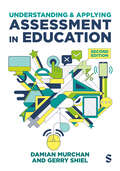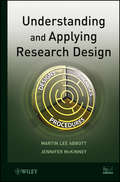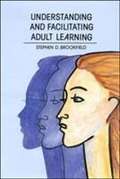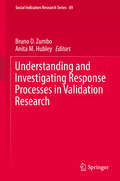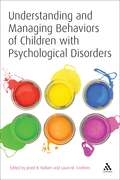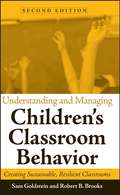- Table View
- List View
Understanding and Applying Assessment in Education
by Gerry Shiel Damian MurchanAll teachers are responsible for assessing the children they teach, and the outcomes of any assessment are important for individual learners, schools and wider education systems. Designed as a pragmatic guide for new teachers and those training to teach, this book is your one-stop-shop for understanding assessment in schools. It covers formative and summative approaches used across primary and secondary education, supporting a balanced overview with policy examples drawn from the UK, Ireland and wider international contexts. This updated second edition reflects recent trends in assessment and includes: more balanced coverage across primary and secondary age phases with a broader range of examples across curriculum subject areas a new chapter on the potential of digital assessment for both formative and summative purposes the impact of the COVID-19 pandemic on assessment in general, and examinations in particular Damian Murchan is Associate Professor in the School of Education at Trinity College Dublin. Gerry Shiel is a Research Fellow at the Educational Research Centre, Dublin, Ireland.
Understanding and Applying Assessment in Education
by Gerry Shiel Damian MurchanAll teachers are responsible for assessing the children they teach, and the outcomes of any assessment are important for individual learners, schools and wider education systems. Designed as a pragmatic guide for new teachers and those training to teach, this book is your one-stop-shop for understanding assessment in schools. It covers formative and summative approaches used across primary and secondary education, supporting a balanced overview with policy examples drawn from the UK, Ireland and wider international contexts. This updated second edition reflects recent trends in assessment and includes: more balanced coverage across primary and secondary age phases with a broader range of examples across curriculum subject areas a new chapter on the potential of digital assessment for both formative and summative purposes the impact of the COVID-19 pandemic on assessment in general, and examinations in particular Damian Murchan is Associate Professor in the School of Education at Trinity College Dublin. Gerry Shiel is a Research Fellow at the Educational Research Centre, Dublin, Ireland.
Understanding and Applying Research Design
by Martin Lee Abbott Jennifer McKinneyA fresh approach to bridging research design with statistical analysis While good social science requires both research design and statistical analysis, most books treat these two areas separately. Understanding and Applying Research Design introduces an accessible approach to integrating design and statistics, focusing on the processes of posing, testing, and interpreting research questions in the social sciences. The authors analyze real-world data using SPSS software, guiding readers on the overall process of science, focusing on premises, procedures, and designs of social scientific research. Three clearly organized sections move seamlessly from theoretical topics to statistical techniques at the heart of research procedures, and finally, to practical application of research design: Premises of Research introduces the research process and the capabilities of SPSS, with coverage of ethics, Empirical Generalization, and Chi Square and Contingency Table Analysis Procedures of Research explores key quantitative methods in research design including measurement, correlation, regression, and causation Designs of Research outlines various design frameworks, with discussion of survey research, aggregate research, and experiments Throughout the book, SPSS software is used to showcase the discussed techniques, and detailed appendices provide guidance on key statistical procedures and tips for data management. Numerous exercises allow readers to test their comprehension of the presented material, and a related website features additional data sets and SPSS code. Understanding and Applying Research Design is an excellent book for social sciences and education courses on research methods at the upper-undergraduate level. The book is also an insightful reference for professionals who would like to learn how to pose, test, and interpret research questions with confidence.
Understanding and Applying Research Design
by Martin Lee Abbott Jennifer McKinneyA fresh approach to bridging research design with statistical analysis While good social science requires both research design and statistical analysis, most books treat these two areas separately. Understanding and Applying Research Design introduces an accessible approach to integrating design and statistics, focusing on the processes of posing, testing, and interpreting research questions in the social sciences. The authors analyze real-world data using SPSS software, guiding readers on the overall process of science, focusing on premises, procedures, and designs of social scientific research. Three clearly organized sections move seamlessly from theoretical topics to statistical techniques at the heart of research procedures, and finally, to practical application of research design: Premises of Research introduces the research process and the capabilities of SPSS, with coverage of ethics, Empirical Generalization, and Chi Square and Contingency Table Analysis Procedures of Research explores key quantitative methods in research design including measurement, correlation, regression, and causation Designs of Research outlines various design frameworks, with discussion of survey research, aggregate research, and experiments Throughout the book, SPSS software is used to showcase the discussed techniques, and detailed appendices provide guidance on key statistical procedures and tips for data management. Numerous exercises allow readers to test their comprehension of the presented material, and a related website features additional data sets and SPSS code. Understanding and Applying Research Design is an excellent book for social sciences and education courses on research methods at the upper-undergraduate level. The book is also an insightful reference for professionals who would like to learn how to pose, test, and interpret research questions with confidence.
Understanding and Challenging the SEND Code of Practice
by Ms Beate HellawellOffering a clear but critical overview and interrogation of the Special Educational Needs and Disability (SEND) Code of Practice 2015, this book provides the context for understanding recent developments in SEND policy reform. It also considers implications for SEND professionalism and partnership working. The book also successfully links policy and theory to practice and has a focus on professional ethics. This book is aimed primarily at higher level students on Masters and professionals engaged in Continuing Professional Development (CPD), and is supported by chapter objectives, case studies, summaries of key concepts and annotated further reading suggestions.
Understanding and Challenging the SEND Code of Practice
by Ms Beate HellawellOffering a clear but critical overview and interrogation of the Special Educational Needs and Disability (SEND) Code of Practice 2015, this book provides the context for understanding recent developments in SEND policy reform. It also considers implications for SEND professionalism and partnership working. The book also successfully links policy and theory to practice and has a focus on professional ethics. This book is aimed primarily at higher level students on Masters and professionals engaged in Continuing Professional Development (CPD), and is supported by chapter objectives, case studies, summaries of key concepts and annotated further reading suggestions.
Understanding and Developing ScienceTeachers’ Pedagogical Content Knowledge: 2nd Edition (Professional Learning #12)
by John Loughran Amanda Berry Pamela MulhallThere has been a growing interest in the notion of a scholarship of teaching. Such scholarship is displayed through a teacher’s grasp of, and response to, the relationships between knowledge of content, teaching and learning in ways that attest to practice as being complex and interwoven. Yet attempting to capture teachers’ professional knowledge is difficult because the critical links between practice and knowledge, for many teachers, is tacit. Pedagogical Content Knowledge (PCK) offers one way of capturing, articulating and portraying an aspect of the scholarship of teaching and, in this case, the scholarship of science teaching. The research underpinning the approach developed by Loughran, Berry and Mulhall offers access to the development of the professional knowledge of science teaching in a form that offers new ways of sharing and disseminating this knowledge. Through this Resource Folio approach (comprising CoRe and PaP-eRs) a recognition of the value of the specialist knowledge and skills of science teaching is not only highlighted, but also enhanced. The CoRe and PaP-eRs methodology offers an exciting new way of capturing and portraying science teachers’ pedagogical content knowledge so that it might be better understood and valued within the profession. This book is a concrete example of the nature of scholarship in science teaching that is meaningful, useful and immediately applicable in the work of all science teachers (preservice, in-service and science teacher educators). It is an excellent resource for science teachers as well as a guiding text for teacher education. Understanding teachers' professional knowledge is critical to our efforts to promote quality classroom practice. While PCK offers such a lens, the construct is abstract. In this book, the authors have found an interesting and engaging way of making science teachers' PCK concrete, useable, and meaningful for researchers and teachers alike. It offers a new and exciting way of understanding the importance of PCK in shaping and improving science teaching and learning. Professor Julie Gess-Newsome Dean of the Graduate School of Education Williamette University This book contributes to establishing CoRes and PaP-eRs as immensely valuable tools to illuminate and describe PCK. The text provides concrete examples of CoRes and PaP-eRs completed in “real-life” teaching situations that make stimulating reading. The authors show practitioners and researchers alike how this approach can develop high quality science teaching. Dr Vanessa Kind Director Science Learning Centre North East School of Education Durham University
Understanding and Developing Student Engagement: Understanding And Developing Student Engagement (SEDA Series)
by Colin BrysonEnhancing the student experience, and in particular student engagement, has become a primary focus of Higher Education. It is in particularly sharp focus as Higher Education moves forward into the uncertain world of high student fees and a developed Higher Education market. Student engagement is a hot topic, in considering how to offer ‘value’ and a better student experience. Moreover it is receiving much attention all over the world and underpins so many other priorities such as retention, widening participation and improving student learning generally. Understanding and Developing Student Engagement draws from a range of contributors in a wide variety of roles in Higher Education and all contributors are actively involved in the Researching, Advancing and Inspiring Student Engagement (RAISE) Network. While utilising detailed case examples from UK universities, the authors also provide a critical review and distillation of the differing paradigms of Student Engagement in America, Australasia, South Africa and Europe, drawing upon key research studies and concepts from a variety of contexts. This book uncovers the multi-dimensional nature of student engagement, utilising case examples from both student and staff perspectives, and provides conceptual clarity and strong evidence about this rather elusive notion. It provides a firm foundation from which to discuss practices and policies that might best serve to foster engagement.
Understanding and Developing Student Engagement (SEDA Series)
by Colin BrysonEnhancing the student experience, and in particular student engagement, has become a primary focus of Higher Education. It is in particularly sharp focus as Higher Education moves forward into the uncertain world of high student fees and a developed Higher Education market. Student engagement is a hot topic, in considering how to offer ‘value’ and a better student experience. Moreover it is receiving much attention all over the world and underpins so many other priorities such as retention, widening participation and improving student learning generally. Understanding and Developing Student Engagement draws from a range of contributors in a wide variety of roles in Higher Education and all contributors are actively involved in the Researching, Advancing and Inspiring Student Engagement (RAISE) Network. While utilising detailed case examples from UK universities, the authors also provide a critical review and distillation of the differing paradigms of Student Engagement in America, Australasia, South Africa and Europe, drawing upon key research studies and concepts from a variety of contexts. This book uncovers the multi-dimensional nature of student engagement, utilising case examples from both student and staff perspectives, and provides conceptual clarity and strong evidence about this rather elusive notion. It provides a firm foundation from which to discuss practices and policies that might best serve to foster engagement.
Understanding And Enriching Problem Solving In Primary Mathematics (Critical Teaching Ser.)
by Patrick Barmby David Bolden Lynn ThompsonEssential reading for all those teaching or training to teach primary mathematics, tackling the knowledge and skills required to successfully teach the tricky area of problem solving.
Understanding and Evaluating Research in Applied and Clinical Settings
by George A. Morgan Jeffrey A. Gliner Robert J. HarmonClinically oriented professionals and students need to understand and evaluate the research and statistics in professional articles, especially given today's emphasis on evidence-based practice. This book demonstrates how the research approach and design help determine the appropriate statistical analysis. Understanding and Evaluating Research in Applied and Clinical Settings features:*short, independent, chapters that do not have to be read in order;*a guide to understanding why a particular statistic was selected;*an emphasis on effects sizes including measures of risk potency;*numerous cross-disciplinary examples to illustrate the material; and*methods to help determine practical and clinical significance and their relation to meta-analysis and evidence-based practice.This book is intended for practitioners and students in psychology, education, counseling, mental and allied health, nursing, and medicine, and as a text for courses on understanding research methods and statistics.
Understanding and Evaluating Research in Applied and Clinical Settings
by George A. Morgan Jeffrey A. Gliner Robert J. HarmonClinically oriented professionals and students need to understand and evaluate the research and statistics in professional articles, especially given today's emphasis on evidence-based practice. This book demonstrates how the research approach and design help determine the appropriate statistical analysis. Understanding and Evaluating Research in Applied and Clinical Settings features:*short, independent, chapters that do not have to be read in order;*a guide to understanding why a particular statistic was selected;*an emphasis on effects sizes including measures of risk potency;*numerous cross-disciplinary examples to illustrate the material; and*methods to help determine practical and clinical significance and their relation to meta-analysis and evidence-based practice.This book is intended for practitioners and students in psychology, education, counseling, mental and allied health, nursing, and medicine, and as a text for courses on understanding research methods and statistics.
Understanding and Facilitating Adult Learning: A Comprehensive Analysis of Principles and Effective Practices (PDF)
by Stephen BrookfieldThis book provides a critical examination of the myths surrounding adult education and its practice.nbsp;
Understanding and Improving the Student Experience in Higher Education: Navigating the Third Space
by Jan Bamford Elena Moschini Cécile TschirhartThis book explores the challenges of improving the student experience in higher education through a ‘third space’ perspective. This key text studies a variety of approaches by drawing on higher education policy, interviews with academics working in third space roles in higher education in the UK, France, Germany, Holland, North America and Italy, as well as auto-ethnographic narratives. The chapters consider key topical areas affecting student experience including academic support, assessment and feedback, creative approaches to pedagogy, approaches to supporting international students and students as partners. This work offers further insights into the way in which the ‘third space’ roles are so important to the functioning of higher education institutions and the ways in which the improvement of the student experience is inexorably intertwined with those in such roles. With evaluative and practice-based insights into embedding institutional changes to improve student outcomes, this book bridges the gap between academia and administration and is ideal reading for anyone interested in improving the student experience within their institution.
Understanding and Improving the Student Experience in Higher Education: Navigating the Third Space
by Jan Bamford Elena Moschini Cécile TschirhartThis book explores the challenges of improving the student experience in higher education through a ‘third space’ perspective. This key text studies a variety of approaches by drawing on higher education policy, interviews with academics working in third space roles in higher education in the UK, France, Germany, Holland, North America and Italy, as well as auto-ethnographic narratives. The chapters consider key topical areas affecting student experience including academic support, assessment and feedback, creative approaches to pedagogy, approaches to supporting international students and students as partners. This work offers further insights into the way in which the ‘third space’ roles are so important to the functioning of higher education institutions and the ways in which the improvement of the student experience is inexorably intertwined with those in such roles. With evaluative and practice-based insights into embedding institutional changes to improve student outcomes, this book bridges the gap between academia and administration and is ideal reading for anyone interested in improving the student experience within their institution.
Understanding and Investigating Response Processes in Validation Research (Social Indicators Research Series #69)
by Bruno D. Zumbo Anita M. HubleyThis volume addresses an urgent need across multiple disciplines to broaden our understanding and use of response processes evidence of test validity. It builds on the themes and findings of the volume Validity and Validation in Social, Behavioral, and Health Sciences (Zumbo & Chan, 2014), with a focus on measurement validity evidence based on response processes. Approximately 1000 studies are published each year examining the validity of inferences made from tests and measures in the social, behavioural, and health sciences. The widely accepted Standards for Educational and Psychological Testing (1999, 2014) present five sources of evidence for validity: content-related, response processes, internal structure, relationships with other variables, and consequences of testing. Many studies focus on internal structure and relationships with other variables sources of evidence, which have a long history in validation research, known methodologies, and numerous exemplars in the literature. Far less is understood by test users and researchers conducting validation work about how to think about and apply new and emerging sources of validity evidence. This groundbreaking volume is the first to present conceptual models of response processes, methodological issues that arise in gathering response processes evidence, as well as applications and exemplars for providing response processes evidence in validation work.
Understanding and Managing Behaviors of Children with Psychological Disorders: A Reference for Classroom Teachers
by Laura M. Crothers Jered B. KolbertIn the vast literature on classroom behavior management, there are no texts that offer a set of behavior management strategies specific to various psychopathology issues in children and adolescents. This book provides a clear, useful resource for educators who wish to either prevent or diminish problem behaviors exhibited in the classroom. Readers are presented with a brief description of various mental health diagnoses, including children on the autistic spectrum, with attention-deficit/ hyperactivity disorder, depression, anxiety, oppositional defiant disorder, and many others. After reviewing the features of each particular disorder, the book then offers a set of classroom management techniques designed to help educators target the associated problematic behaviors. Each chapter is written by an expert in that specific field, and strategies are provided for use with a variety of ages (from early childhood to adolescence). Educators will find this to be an essential tool for working with children and adolescents with a variety of mental health and behavioral disorders in the classroom.
Understanding and Managing Behaviors of Children with Psychological Disorders: A Reference for Classroom Teachers
by Laura M. Crothers Jered B. KolbertIn the vast literature on classroom behavior management, there are no texts that offer a set of behavior management strategies specific to various psychopathology issues in children and adolescents. This book provides a clear, useful resource for educators who wish to either prevent or diminish problem behaviors exhibited in the classroom. Readers are presented with a brief description of various mental health diagnoses, including children on the autistic spectrum, with attention-deficit/ hyperactivity disorder, depression, anxiety, oppositional defiant disorder, and many others. After reviewing the features of each particular disorder, the book then offers a set of classroom management techniques designed to help educators target the associated problematic behaviors. Each chapter is written by an expert in that specific field, and strategies are provided for use with a variety of ages (from early childhood to adolescence). Educators will find this to be an essential tool for working with children and adolescents with a variety of mental health and behavioral disorders in the classroom.
Understanding and Managing Children's Behaviour through Group Work Ages 3-5: A child–centred approach
by Cath HunterUnderstanding and Managing Children’s Behaviour through Group Work Ages 3-5 provides the reader with an insight into children’s emotional well-being and helps them to understand what and how children communicate and how to respond in a way that provides positive messages, increases their emotional vocabulary and encourages them to change their behaviour. It provides an alternative and effective child centred way of managing children’s behaviour through introducing the concept of reflective language and other tools, equipping staff with new skills that are transferable across the school in any role. The book is divided into two sections, enabling the reader to link theory with practice. The first section takes the reader on a journey to help them understand the different factors that influence children’s behaviour. The second section of the book focuses on the group work programmes, how they can be used, their value and the impact they can have on children and the classroom environment as a whole. The activities in the group work programme explore the concept of using reflective language as a behaviour management tool and are designed to motivate, build confidence, self-esteem and resilience. Useful pedagogical features throughout the book include:- Practitioner and classroom management tips and reflective tasks; Strategies and practical ideas for staff to use to help them engage more deeply with the contents of the book; Flexible, tried and tested group work programmes designed to promote inclusion rather than exclusion; Clear step by step instructions for delivering the work programmes; Case studies showing behaviour examples with detailed explanations for the behaviour and strategies to respond to it. The book is aimed at all early years practitioners and any students training to work with children of E.Y.F.S age. It is also recommended reading for SENCOs and trainee teachers and will also be useful for therapists who work with children and are looking at delivering other approaches in their work.
Understanding and Managing Children's Behaviour through Group Work Ages 3-5: A child–centred approach
by Cath HunterUnderstanding and Managing Children’s Behaviour through Group Work Ages 3-5 provides the reader with an insight into children’s emotional well-being and helps them to understand what and how children communicate and how to respond in a way that provides positive messages, increases their emotional vocabulary and encourages them to change their behaviour. It provides an alternative and effective child centred way of managing children’s behaviour through introducing the concept of reflective language and other tools, equipping staff with new skills that are transferable across the school in any role. The book is divided into two sections, enabling the reader to link theory with practice. The first section takes the reader on a journey to help them understand the different factors that influence children’s behaviour. The second section of the book focuses on the group work programmes, how they can be used, their value and the impact they can have on children and the classroom environment as a whole. The activities in the group work programme explore the concept of using reflective language as a behaviour management tool and are designed to motivate, build confidence, self-esteem and resilience. Useful pedagogical features throughout the book include:- Practitioner and classroom management tips and reflective tasks; Strategies and practical ideas for staff to use to help them engage more deeply with the contents of the book; Flexible, tried and tested group work programmes designed to promote inclusion rather than exclusion; Clear step by step instructions for delivering the work programmes; Case studies showing behaviour examples with detailed explanations for the behaviour and strategies to respond to it. The book is aimed at all early years practitioners and any students training to work with children of E.Y.F.S age. It is also recommended reading for SENCOs and trainee teachers and will also be useful for therapists who work with children and are looking at delivering other approaches in their work.
Understanding and Managing Children's Behaviour through Group Work Ages 5-7: A child-centred programme
by Cath HunterUnderstanding and Managing Children’s Behaviour 5-7 provides the reader with an insight into children’s emotional well-being and helps them to understand what and how children communicate and how to respond in a way that provides positive messages, increases their emotional vocabulary and encourages them to change their behaviour. It provides an alternative and effective child-centred way of managing children’s behaviour through introducing the concept of reflective language and other tools, equipping staff with new skills that are transferable across the school in any role. The book is divided into two sections, enabling the reader to link theory with practice. The first section takes the reader on a journey to help them understand the different factors that influence children’s behaviour. The second section of the book focuses on the group work programmes, how they can be used, their value and the impact they can have on children and the school as a whole. The activities in the group work programmes explore the concept of using reflective language as a behaviour management tool and are designed to motivate and build confidence, self-esteem and resilience. Useful pedagogical features throughout the book include: practitioner and classroom management tips and reflective tasks; strategies and practical ideas for staff to use to help them engage more deeply with the contents of the book; flexible, tried and tested group work programmes designed to promote inclusion rather than exclusion; clear step-by-step instructions for delivering the group work programmes; case studies showing behaviour examples with detailed explanations for the behaviour and strategies to respond to it. This book is aimed at all KS1 primary school staff, especially teaching assistants, learning mentors and family workers who can deliver the group work programmes. It is also recommended reading for SENCOs and trainee teachers, and will be useful for therapists who work with children and are looking at delivering other approaches in their work.
Understanding and Managing Children's Behaviour through Group Work Ages 5-7: A child-centred programme
by Cath HunterUnderstanding and Managing Children’s Behaviour 5-7 provides the reader with an insight into children’s emotional well-being and helps them to understand what and how children communicate and how to respond in a way that provides positive messages, increases their emotional vocabulary and encourages them to change their behaviour. It provides an alternative and effective child-centred way of managing children’s behaviour through introducing the concept of reflective language and other tools, equipping staff with new skills that are transferable across the school in any role. The book is divided into two sections, enabling the reader to link theory with practice. The first section takes the reader on a journey to help them understand the different factors that influence children’s behaviour. The second section of the book focuses on the group work programmes, how they can be used, their value and the impact they can have on children and the school as a whole. The activities in the group work programmes explore the concept of using reflective language as a behaviour management tool and are designed to motivate and build confidence, self-esteem and resilience. Useful pedagogical features throughout the book include: practitioner and classroom management tips and reflective tasks; strategies and practical ideas for staff to use to help them engage more deeply with the contents of the book; flexible, tried and tested group work programmes designed to promote inclusion rather than exclusion; clear step-by-step instructions for delivering the group work programmes; case studies showing behaviour examples with detailed explanations for the behaviour and strategies to respond to it. This book is aimed at all KS1 primary school staff, especially teaching assistants, learning mentors and family workers who can deliver the group work programmes. It is also recommended reading for SENCOs and trainee teachers, and will be useful for therapists who work with children and are looking at delivering other approaches in their work.
Understanding and Managing Children's Behaviour through Group Work Ages 7 - 11: A child-centred programme
by Cath Hunter'I would highly recommend the skills, expertise and delivery that Cath can bring to a school and can guarantee that any school following her advice will not regret it.' Carl McIver, Head of School, St. Willibrord's R.C. Primary, Manchester 'I have worked with Cath Hunter now in two schools and find that the work she does with children, parents and staff is amazing.' Sam Foord, Headteacher, Ravensbury Community School, Manchester Understanding and Managing Children’s Behaviour provides the reader with an insight into children’s emotional wellbeing and helps them to understand what and how children communicate and how to respond in a way that provides positive messages, increases their emotional vocabulary and encourages them to change their behaviour. It provides an alternative and effective child centred way of managing children’s behaviour through introducing the concept of reflective language and other tools, equipping staff with new skills that are transferable across the school in any role. The book is divided into two sections, enabling the reader to link theory with practice. The first section takes the reader on a journey to help them understand the different factors that influence children’s behaviour. The second section of the book focuses on the group work programmes, how they can be used, their value and the impact they can have on children and the school as a whole. The activities in the group work programme explore the concept of using reflective language as a behaviour management tool and are designed to motivate, build confidence, self-esteem and resilience. Useful pedagogical features throughout the book include:- Practitioner and classroom management tips and reflective tasks; Strategies and practical ideas for staff to use to help them engage more deeply with the contents of the book; Flexible, tried and tested group work programmes designed to promote inclusion rather than exclusion; Clear step by step instructions for delivering the work programmes; Case studies showing behaviour examples with detailed explanations for the behaviour and strategies to respond to it. The book is aimed at all primary school staff, especially teaching assistants, learning mentors and family workers who can deliver the group work programmes. It is also recommended reading for SENCOs and trainee teachers and will also be useful for therapists who work with children and are looking at delivering other approaches in their work.
Understanding and Managing Children's Behaviour through Group Work Ages 7 - 11: A child-centred programme
by Cath Hunter'I would highly recommend the skills, expertise and delivery that Cath can bring to a school and can guarantee that any school following her advice will not regret it.' Carl McIver, Head of School, St. Willibrord's R.C. Primary, Manchester 'I have worked with Cath Hunter now in two schools and find that the work she does with children, parents and staff is amazing.' Sam Foord, Headteacher, Ravensbury Community School, Manchester Understanding and Managing Children’s Behaviour provides the reader with an insight into children’s emotional wellbeing and helps them to understand what and how children communicate and how to respond in a way that provides positive messages, increases their emotional vocabulary and encourages them to change their behaviour. It provides an alternative and effective child centred way of managing children’s behaviour through introducing the concept of reflective language and other tools, equipping staff with new skills that are transferable across the school in any role. The book is divided into two sections, enabling the reader to link theory with practice. The first section takes the reader on a journey to help them understand the different factors that influence children’s behaviour. The second section of the book focuses on the group work programmes, how they can be used, their value and the impact they can have on children and the school as a whole. The activities in the group work programme explore the concept of using reflective language as a behaviour management tool and are designed to motivate, build confidence, self-esteem and resilience. Useful pedagogical features throughout the book include:- Practitioner and classroom management tips and reflective tasks; Strategies and practical ideas for staff to use to help them engage more deeply with the contents of the book; Flexible, tried and tested group work programmes designed to promote inclusion rather than exclusion; Clear step by step instructions for delivering the work programmes; Case studies showing behaviour examples with detailed explanations for the behaviour and strategies to respond to it. The book is aimed at all primary school staff, especially teaching assistants, learning mentors and family workers who can deliver the group work programmes. It is also recommended reading for SENCOs and trainee teachers and will also be useful for therapists who work with children and are looking at delivering other approaches in their work.
Understanding and Managing Children's Classroom Behavior: Creating Sustainable, Resilient Classrooms (Wiley Series on Personality Processes #207)
by Sam Goldstein Robert B. Brooks"This book sets the standard in delivering a comprehensive, state-of-the-art approach for understanding, treating, and preventing classroom behavior difficulties. It should be on the bookshelves of all professionals who work in school settings. I will certainly recommend this text to my colleagues and students." —George J. DuPaul, PhD, Professor of School Psychology, Associate Chair, Education and Human Services, Lehigh University A classic guide to creating a positive classroom environment Covering the most recent and relevant findings regarding behavior management in the classroom, this new edition of Understanding and Managing Children's Classroom Behavior has been completely updated to reflect the current functional approach to assessing, understanding, and positively managing behavior in a classroom setting. With its renewed focus on the concept of temperament and its impact on children's behavior and personality, Understanding and Managing Children's Classroom Behavior emphasizes changing behavior rather than labeling it. Numerous contributions from renowned experts on each topic explore: How to identify strengths and assets and build on them Complete functional behavioral assessments The relationship between thinking, learning, and behavior in the classroom Practical strategies for teachers to improve students' self-regulation How to facilitate social skills Problem-solving approaches to bullies and their victims Medications and their relationship to behavior The classic guide to helping psychologists, counselors, and educators improve their ability to serve all students, Understanding and Managing Children's Classroom Behavior, Second Edition will help educators create citizens connected to each other, to their teachers, to their families, and to their communities.
